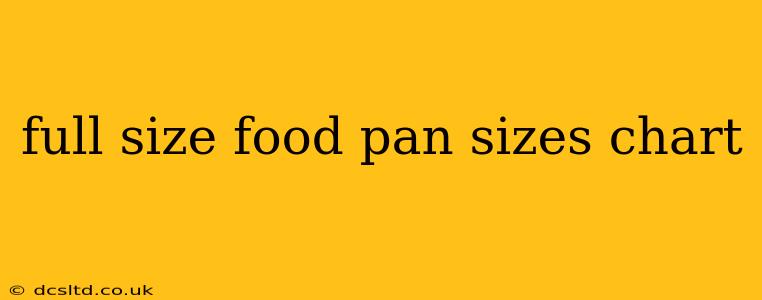Choosing the right size food pan is crucial for efficient food preparation, storage, and service, whether you're running a restaurant kitchen, a catering business, or simply a home cook. This comprehensive guide provides a detailed full-size food pan sizes chart, along with answers to frequently asked questions to help you navigate the world of food pan dimensions.
Understanding the standardized sizes of full-size food pans is essential for ensuring compatibility with your equipment, like ovens, refrigerators, and bain-maries. These pans are designed to nest and stack, maximizing space efficiency. Let's dive into the details.
Full-Size Food Pan Dimensions Chart
The standard full-size food pan is based on a 12-inch x 20-inch rectangular shape. However, the depth varies, creating different capacities. This chart outlines the common depths and their approximate capacities (note that these are estimates and may vary slightly depending on the manufacturer):
| Pan Size (Depth) | Dimensions (Inches) | Approximate Capacity (Quarts) | Approximate Capacity (Liters) | Notes |
|---|---|---|---|---|
| 2" | 12" x 20" x 2" | 6-7 | 5.7-6.6 | Shallow pan, ideal for sauces or shallow-fried items |
| 4" | 12" x 20" x 4" | 12-14 | 11.4-13.2 | Versatile depth, suitable for a variety of applications |
| 6" | 12" x 20" x 6" | 18-20 | 17-19 | Deep pan, suitable for large batches of soups, stews, or roasted vegetables |
Important Note: These are approximate capacities. The actual capacity may vary slightly depending on the manufacturer and the material of the pan. Always check the manufacturer's specifications for precise measurements.
What are the different types of food pans?
Food pans aren't just about size; the material also matters. You'll commonly find food pans made from:
- Stainless Steel: Durable, easy to clean, and resistant to corrosion. They are a popular choice for commercial kitchens due to their longevity.
- Aluminum: Lightweight and heats up quickly, making them ideal for even cooking. However, they may be more susceptible to scratching and dents.
- Polycarbonate: Ideal for use in bain-maries or hot holding applications, as they are designed to withstand higher temperatures compared to other materials.
The choice of material often depends on the application and budget.
What size food pan do I need for a specific recipe?
This depends heavily on the recipe! Consider the following:
- Recipe Yield: How much food are you making? Larger recipes require larger pans.
- Cooking Method: Some methods, like braising, require more depth than others.
- Storage Needs: Will you be storing the food in the pan? Factor in the space required.
It is always a good idea to slightly overestimate the pan size needed to avoid overflow during cooking.
How do I choose the right food pan for my kitchen equipment?
Before purchasing food pans, it's crucial to measure your existing equipment, such as ovens, refrigerators, and bain-maries, to ensure compatibility. Full-size food pans are designed to fit standard commercial equipment, but confirming the dimensions beforehand prevents incompatibility issues.
What are the benefits of using standardized food pans?
Standardized food pans offer several advantages:
- Stackability: They are designed to stack efficiently, saving valuable storage space.
- Interchangeability: They can be used across different equipment within your kitchen.
- Easy Cleaning: Their smooth surfaces make them easy to clean and maintain.
- Efficient Inventory Management: Standardized sizes simplify ordering and managing your food pan inventory.
By understanding the dimensions and features of full-size food pans, you can optimize your food preparation and storage processes. Remember to always check the manufacturer's specifications for the most accurate dimensions and capacities.
